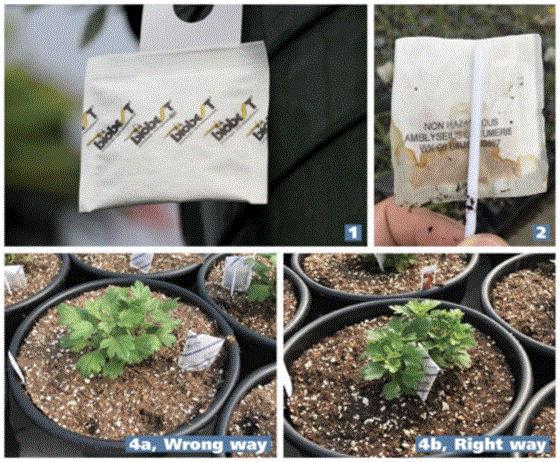The Starting Line ...

I’m starting to feel in a groove now, three weeks into this Tech On Demand e-newsletter. They say it takes about 66 days to form a habit, so we’re well on our way there.
Speaking of habits, I recently finished an excellent book with members of my book club called "The Power of Habit: Why We Do What We Do in Life and Business," by Charles Duhigg. It’s a good read (once you get through busy season, of course). Fantastic tips for setting good personal habits as well as organizational habits for your operation.
Okay, I can’t get going on books or we’ll be here all day … Let’s jump into the technical information.
This Week's Tips from Maryland Extension
This week’s University of Maryland Extension Greenhouse TPM/IPM Report hit my inbox on March 12 and the content was so timely that I decided to make sure you’re all aware of this resource. The current issue addresses insects like thrips, broad mites and aphids, plus powdery mildew. The researchers give a heads up on what to watch for this time of year, and suggest control measures.

Stay ahead of challenges by subscribing to the weekly report from UMD and bookmarking their IPMNet website. You can also find the absolute latest news from the UMD greenhouse extension team on their IPMNet Facebook page.
Keeping Impatiens IDM-Free
It’s exciting to have impatiens back in greenhouses across North America following those dark, dreary few years without this colorful shade-garden staple. Thanks to new IDM- (impatiens downy mildew) resistant varieties, many of you are back in the impatiens game. But even if you’re growing Beacon or Imara, there’s still risk. IDM won’t kill these new genetics, but the spores can still live on them and transfer to susceptible varieties. You need to follow established protocols to keep crops clean, because it is unacceptable to send them to market carrying IDM.

With that in mind, the Tech On Demand team recently released a new VIDEO on impatiens as an at-risk crop, along with additional resources available to help you create a complete IDM management strategy.
Check out these GROWER GUIDELINES and a detailed video on FUNGICIDE ROTATIONS. When you take the appropriate measures, you minimize your risk.
Nick's Tip of the Week
Each week, I’ll work with my partner in crime Nick Flax, one of the newest technical services experts at Ball, to share a concern that’s come up during one of his numerous calls with growers across North America. This week he’s diving into edema on thunbergia.
Question: Over the past couple of weeks, multiple growers have reached out reporting strange leaf spots and growths on the tops and undersides of thunbergia leaves, particularly in the Midwest and Northeast. They also report no obvious signs of insect pests or mites, or signs and symptoms of disease-causing pathogens. What is this, and how do you prevent it?

Nick’s Tip: This is classic edema symptomology, and thunbergia are especially prone to this disorder. What you’re seeing is damage from excessive water pressure (turgor) rupturing cells in the leaf. This can occur when substrate moisture is high; during cloudy, rainy weather; and under humid greenhouse conditions. The tannish spots and bumps you see are callus tissue forming around the injured cells.
If propagating thunbergia from vegetative cuttings, be sure to run your substrate drier than you would for most other crops to hopefully prevent this from occurring. For you VPD users, this equates to a very steep VPD curve shortly after sticking cuttings and getting them turgid.
Ivy geraniums are another crop this disorder is fairly common on, but I have also received several reports of edema on zonal and interspecific geraniums. If edema occurs on geraniums, symptoms will typically only appear on the underside of the leaf.
To combat edema, try to grow crops drier or, rather than drying crops down heavily between irrigations, maintain a more constant, moderate substrate moisture level.

"Release the Beasts"—a Predatory Mites Tale
The article title grabbed my attention when I was flipping through the latest issue of GrowerTalks, and after reading what John Sanderson, Suzanne "Buglady" Wainwright-Evans and Ronald Valentin wrote about predatory mites, I wanted to call special attention to the story.
Predatory mites like Neoseiulus cucumeris, N. californicus, Amblyseius swirskii, A. andersoni and Phytoseiulus persimilis are commonly used biocontrols in greenhouses these days when doing battle with thrips, whiteflies and mites. But the level of control achieved depends heavily on how they are introduced into the environment.

Whether using sachets or sprinkling/broadcasting predatory mites, care must be taken to optimize their benefits. Improper distribution or environmental nuances like bright sunlight, moisture and temperature can greatly reduce effectiveness.
To avoid wasting time, labor or money, check out the story "RELEASE THE BEASTS" in our digital edition (or look for it on page 64 of your print edition). It’s well worth the read.

2021 HRI Research Projects Released

Our industry’s Horticultural Research Initiative is focused on leading the way into the future by funding the most cutting-edge research projects. With the unveiling of 2021 projects, we should all be very excited for the future! From transparent solar cell designs and LED technology for garden mum production to quantifying the attractiveness of plants to pollinators and how COVID-19 plant purchase behavior could mold the habits of consumers in the future, the diversity of projects is great and the information gained will be gamechanging.
There are many more projects besides the ones highlighted above and you can find them all HERE.
Take a look and get excited, because the future is bright and so are the folks leading research in our industry. Thanks to HRI and AmericanHort for making research a priority.
... The Finish Line
In addition to writing this weekly newsletter, I also have the opportunity to talk to industry leaders for our "Tech On Demand" podcast, brought to you by GrowerTalks. I’ve hosted more than 60 greenhouse podcast episodes over the past few years and each one is unique—as are the guests!
This week, I was thrilled to release my second podcast featuring Bryce Anderson, sales manager for container company The HC Companies. This time we talked about the challenging topic of product differentiation—I mean, a red geranium is a red geranium, right? (In fact, that was my first question to Bryce.)
Check out our entertaining conversation titled HOW TO LEVEL UP YOUR VALUE PROPOSITION. You can subscribe to the podcast on all major podcast apps like iTunes, Google, Spotify, Stitcher and more so you never miss an episode.



I hope this edition of Tech On Demand offered information to help you grow your best crops ever. My email is bcalkins@ballhort.com if you have any comments, suggestions or challenges we can help solve.

Bill Calkins
Editor - Tech On Demand
This email was received by you and 22,115 other fine subscribers!
If you're interested in advertising in Tech On Demand, contact Kim Brown ASAP and she'll hook you up.